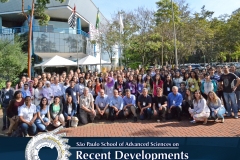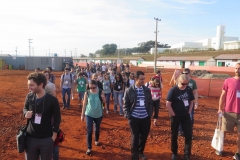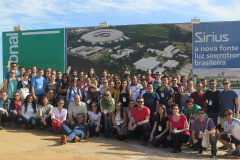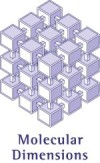New!
SyncLight school reported in Synchrotron Radiation News
SyncLight 2015 School gathers 96 students and 21 leading researchers around advanced synchrotron light-based techniques and applications
From July 13th to 24th, 96 young researchers from 17 countries and 27 different nationalities were gathered at the Brazilian Synchrotron Light Laboratory (LNLS), in Campinas (São Paulo, Brazil) in order to learn about synchrotron techniques in a comprehensive way.
SyncLight 2015, the São Paulo School of Advanced Sciences (ESPCA) on Recent Developments in Synchrotron Radiation, had the main goal of presenting the numerous new experimental possibilities that the last generation synchrotron light sources are opening for scientific research in different disciplines.
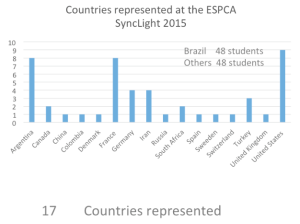 |
 |
Sponsored by the São Paulo State’s Research Foundation (FAPESP) and organized jointly by the LNLS and the American Physical Society (APS), the two-week-school provided training for MSc, PhD and Post-doc students in the fields of physics, chemistry, biology, geosciences, medicine and materials science engineering, among others. The interdisciplinary character of the school was planned to provide fruitful exchanges between researchers related to these different disciplines.
The LNLS, located at the campus of the CNPEM (National Center for Research in Energy and Materials), was a particularly appropriate host to the school considering its current engagement in the development and construction of Sirius, a latest generation synchrotron light source. Sirius is designed to be one of the brightest sources in the world. When its first light is emitted, in 2018, it will be one of the first fourth generation light sources to start operation.
The main objective of the SyncLight 2015 was preparing and motivating the new generation of users that will benefit from this new big scientific tool and its advanced beamlines. This objective has been greatly achieved thanks to the outstanding level of the lecturers and enthusiastic participation of the students, as stated by one of these outstanding lecturers, Cinzia Giannini (CNR, Italy): “The atmosphere was extremely stimulating, the school perfectly organized and I really enjoyed to be part of it.”
Lectures
Antonio José Roque da Silva, director of LNLS, who presented the Sirius project and introduced the synchrotron light as one of the main tools for research, welcomed SyncLight 2015 participants. He was followed by the talk of Carlos Henrique de Brito Cruz, Scientific Director of FAPESP (São Paulo Research Foundation), who highlighted the importance of the ESPCA program to enhance relevant exchanges between scientific institutions and researchers from São Paulo State and abroad.
Following them, 21 currently active and leading researchers around the world, 7 of them from Brazil and 14 from other countries, presented the scientific topics. In total, there were 34 lectures.
Some of the advanced techniques covered were X-ray optics, X-ray diffraction, X-ray spectroscopies, X-ray elastic and inelastic scattering, X-ray imaging with nanofocus and coherent light and high pressure with X-rays, spread over many different topics as medicine, catalysis, environment, magnetic materials, diamond synthesis, soil and plants, amongst others.
Maria Carmem Asensio (Soleil, France), who gave a talk about angle resolved photo emission spectroscopy (ARPES), considered SyncLight School as a fruitful experience for everybody: “I hope that will be the origin of many positive projects in the near future, specially for the young people”, she stated.
The lecturers were Aldo Craievich (University of São Paulo, Brazil), Andrea Dessen (Centre National de la Recherche Scientifique – CNRS, France), Cinzia Giannini (Consiglio Nazionale delle Ricerche – CNR, Italy), Dalton Abdala (Brazilian Synchrotron Light Laboratory – LNLS/CNPEM, Brazil), Daniel Haskel (APS, Argonne National Laboratory, USA), Daniela Zanchet (University of Campinas, Unicamp, Brazil), Dennis M. Mills (APS, Argonne National Laboratory, USA), Donald Sparks (University of Delaware), Eduardo Granado (University of Campinas, Unicamp, Brazil), Ercan Alp (APS, Argonne National Laboratory, USA), Ian Robinson (UCL – London Centre for Nanotechnology, UK), Jianwei Miao (University of California – UCLA, USA), Julio Criginski Cezar (Brazilian Synchrotron Light Laboratory – LNLS/CNPEM, Brazil), Liu Lin (Brazilian Synchrotron Light Laboratory – LNLS/CNPEM, Brazil), Maria Carmen Asensio (Soleil Synchrotron, France), Mario T. Murakami (Brazilian Biosciences National Laboratory – LNBio/CNPEM, Brazil), Narcizo Marques (Brazilian Synchrotron Light Laboratory – LNLS/CNPEM, Brazil), Pieter Glatzel (European Synchrotron Radiation Facility – ESRF, France), Ruben Reininger (APS, Argonne National Laboratory, USA), Ryan V. Tappero (NSLS, Brookhaven National Laboratory, USA) and Simo Huotari (University of Helsinki, Finland). The lectures given by each speaker are detailed here.
Hands-on on synchrotron related techniques
During the afternoons the school also offered tutorials and hands-on experiments to the participants on the 17 current beamlines available at the LNLS light source. There were also tutorials on the accelerator, x-ray detectors and x-ray optics. Presented and accompanied by the LNLS researchers, the tutorials covered spectroscopy, diffraction and imaging techniques.
The students also had the opportunity to visit the ongoing building works of Sirius, the new Brazilian synchrotron light source, located next to the CNPEM campus. During the visit they were able to walk along the future storage ring tunnel and to learn about the great challenges involved in a building with unprecedented mechanical and thermal stability requirements.
According to Esen Ercan Alp, senior scientist at Argonne National Laboratory and one of the event´s organizer from APS (American Physics Society), the school was able to attract some of the best young researchers in the world, as well as the leading scientists to lecture: “Complemented with a superb hands-on experiments in the afternoon, the school provided an unprecedented opportunity for the students and postdoctoral researchers, who were gathered from all around the world.”
Ercan also highlighted the importance of the program initiative for the success of the school: “ The vision of the funding agency, FAPESP, in terms of making Brazil a destination country for young talents to come and work can only be realized by showing the opportunities it has in research laboratories and in its Universities. Thus, one of the important aspects of the school in terms of explaining and showing the real opportunities available in Brazil was accomplished, with students sharing 13 days in Brazil with their own peers”.
About ESPCA
São Paulo School of Advanced Science (ESPCA) is a program of FAPESP (São Paulo Research Foundation) which offers funding for the organization of courses in advanced research in the different areas of knowledge in São Paulo State.
Each ESPCA is expected to offer short duration courses (around 2 weeks) on advanced themes in science and technology, contributing to the formation of the young attendants. Through this initiative FAPESP expects to establish, in the State of São Paulo, a globally competitive hub for talented researchers.
About LNLS
The Brazilian Synchrotron Light Laboratory (LNLS), located in Campinas, at São Paulo state, operates the only synchrotron light source in Latin America, providing high brilliant light from infrared to X-rays for the analysis of organic and inorganic materials. Designed and built with Brazilian technology, LNLS was inaugurated in 1997 as an open facility to the scientific and industrial communities across the country and abroad.
LNLS is currently engaged in the development and construction of Sirius, the next Brazilian synchrotron light source. It is planned to be a state of the art fourth generation machine, designed to be one of the most advanced in the world. Its ultra-low emittance and thus high brightness will open up new perspectives for research in many fields such as material science, structural biology, nanoscience, physics, earth and environmental science, cultural heritage, among many others. It is scheduled to start commissioning in 2018 and to be opened to users in 2019.
About CNPEM
The National Centre for Research in Energy and Materials (CNPEM) is a non-profit private institution, qualified as Social Organization by the Federal Government (Decree No. 2.405/97 and Law 9637/98). Its goal is to manage four national laboratories for the Ministry of Science, Technology and Innovation (MCTI): Synchrotron Light (LNLS), Biosciences (LNBio), Science and Technology of Bioethanol (CTBE) and Nanotechnology (LNNano).
The LNLS operates the only Synchrotron Light Source in Latin America and a set of scientific instrumentation for the analysis of organic and inorganic materials; LNBio conducts researches in frontier areas of Bioscience, focusing on biotechnology and drugs; The CTBE investigates new technologies in bioenergy; and LNNano conducts investigations with advanced materials, besides hosting the China-Brazil Binational Center for Nanotechnology.
The four national laboratories have facilities open to academic and business communities of Brazil and overseas. On average, 1900 external researchers are benefited annually by the campus infrastructure. The laboratories also develop their own research projects and participate in the cross-investigation agenda coordinated by the CNPEM, combining facilities and scientific skills around strategic themes related to energy and materials.
Other two areas of action of the Center include the fostering of partnerships with companies in the agriculture, industry and services to support innovation processes; and promoting training and capacity activities of the academic and business communities. In the coming years, this research complex – whose formation began in 1997 with the inauguration of the LNLS – should gain even greater projection in the scientific and technological scenarios of Brazil and abroad. Such projection will come from the opening of the new synchrotron light source (Sirius), currently under construction.
Sponsors
Silver
Bronze
